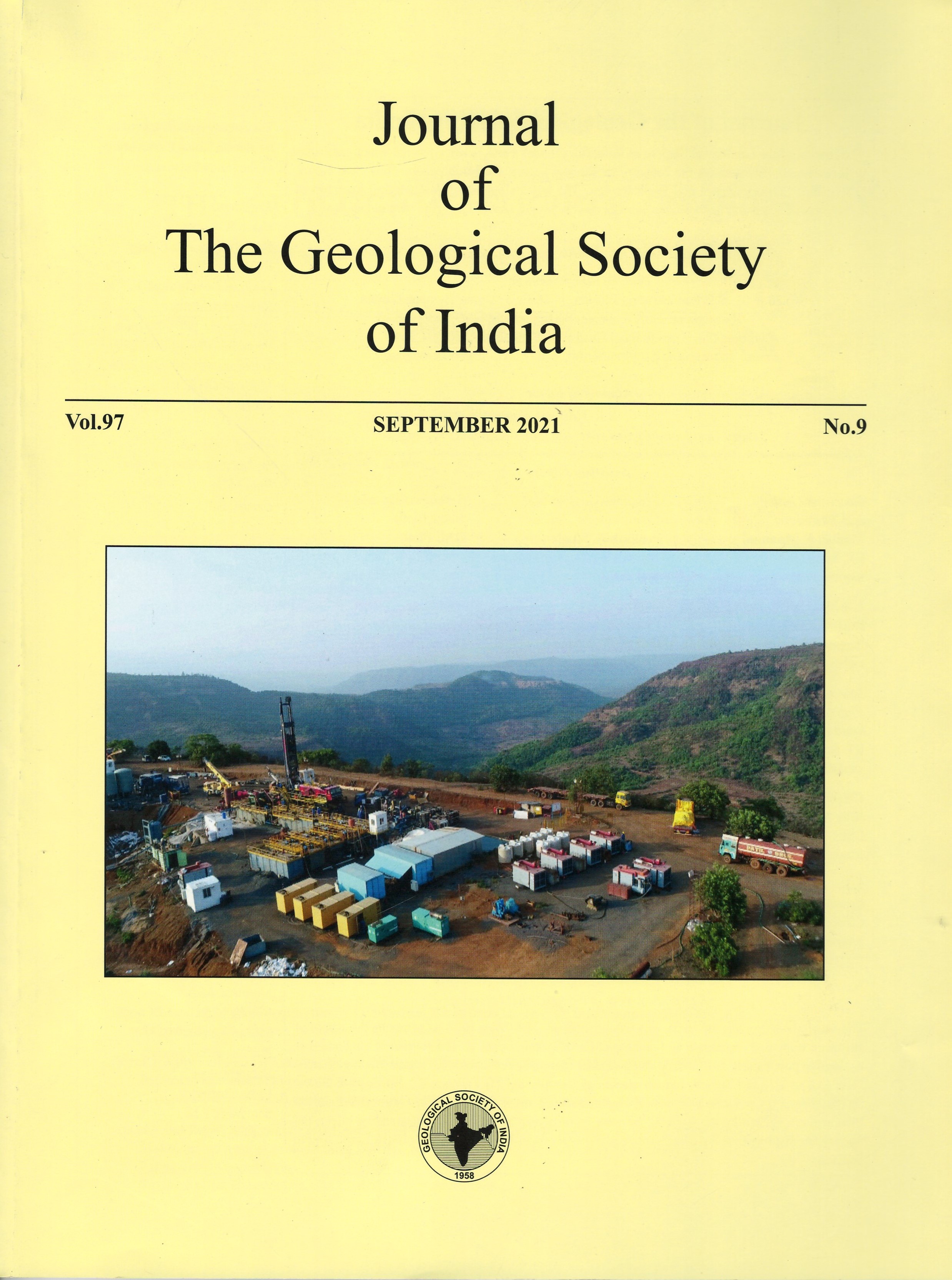GIS Based Spatial and Temporal Investigation of Groundwater and Soil Quality along Noyyal River, Tiruppur, India
DOI:
https://doi.org/10.1007/s12594-021-1825-9Keywords:
No KeywordsAbstract
Soil and water quality crisis owing to industrialization is massive at present due to the illegal discharge of wastewater to the environment. Textile is one such industry, discharges untreated wastewater into nearby environment and poses major threats worldwide. Similar situation was observed for the last three decades (1980–2013) along Noyyal river in Tiruppur, India. Since 2013, zero liquid discharge (ZLD) has been adopted by the textile industries in Tiruppur to reduce further deterioration of environment. The groundwater from open wells and soil from agricultural land was examined continuously for three years (2015, 2016 and 2017) in order to assess the existing environment status along Noyyal river basin in Tiruppur. The GIS study reveals that 71% of groundwater remains unsuitable for drinking and also 54% are unfit for irrigation use. The findings further reveal that 61% of surface and 20% of subsurface soils are not suitable for agriculture. The detailed investigations established that the open wells located in the downstream of textile industries and near to Orathupalayam reservoir are highly contaminated with organic and inorganic contaminants associated with textile processing activities. The temporal variation of groundwater in these open wells indicated that the dilution by rainwater is very slow. It is also identified that soils near to the contaminated open wells are extremely affected and soil of 15 cm depth is extremely contaminated. Thus, implementation of ZLD somewhat reduced discharge of wastewater into the basin; however the recovery of groundwater to potable quality and soils for agriculture production needs immediate remediation.
Downloads
Metrics
Issue
Section
Published
How to Cite
References
Appasamy, P.P. and Nelliyat, P. (2007) Compensating the Loss of Ecosystem Services Due to Pollution in Noyyal River Basin, Tamil Nadu. Madras School of Economics, Chennai, pp.1-7.
Arumugam, K. (2010) Assessment of groundwater quality in Tirupur region. PhD Thesis, Anna University, Chennai, pp.1-300.
Arumugam, K., Kumar, A.R., Elangovan, K. (2014). Assessment of groundwater quality using water quality index in Avinashi–Tirupur– Palladam Region, Tamil Nadu, India. Internat. Jour. Appl. Eng. Res., v.9, pp. 12177–12191.
Bernhardt, A., Gysi, N. (2016) World’s worst pollution problems - The toxics beneath our feet. Pure Earth and Green Cross, Switzerland, pp.1-56.
BIS (2015) Guidelines for Drinking Water, Government of India, New Delhi. BIS (1987) IS 2720-26: Method of test for soils, Part 26: Determination of pH value, Government of India, New Delhi.
BIS (1985) IS 2720 – Part 4, Indian standard for engineering properties of soils, Government of India, New Delhi.
BIS (1980) IS 2720-3-2: Methods of test for soils, Part 3: Determination of specific gravity, Section 2: Fine, medium and coarse grained soils, Government of India, New Delhi.
BIS (1977) IS 2720-21: Methods of Test for Soils, Part 21: Determination of Total Soluble Solids, Government of India, New Delhi.
CPCB (2016) Report on Assessment of Pollution from Textile Dyeing Units in Tiruppur, Tamil Nadu and Measures Taken to Achieve Zero Liquid Discharge, Central Pollution Control Board - Zonal Office (South), Bengaluru, pp.1-87.
Furn, K. (2004) Effects of dyeing and bleaching industries on the area around the Orathupalayam Dam in Southern India, Water Technology Centre, Tamil Nadu Agricultural University, Coimbatore and Uppsala University, and the Swedish University of Agricultural Sciences, pp.1-99.
Ghaly, A.E., Ananthashankar, R., Alhattab, M., V.V., R. (2014) Production, Characterization and Treatment of Textile Effluents: A Critical Review. Jour. Chem. Eng. Process Technol., v.5, pp. 1–18. DOI: 10.4172/2157- 7048.1000182
Hussain, A.Z., and Mohamed Sheriff, K.M. (2015) Assessment of Groundwater Quality for Irrigation on the Bank of Noyyal River at Tiruppur, Tamil Nadu, India. Int. Lett. Chem. Phys. Astron., v.57, pp.1–6. DOI:10.18052/ www.scipress.com/ILCPA.57.1
Joseph E. Bowles (2001) Engineering properties of soils and their measurement, 4th edition. McGraw-Hill Companies, 481p.
Lasota, J., B³oñska, E., £yszczarz, S., Tibbett, M. (2020) Forest Humus Type Governs Heavy Metal Accumulation in Specific Organic Matter Fractions. Water. Air. Soil Pollut., v.231, pp. 1–13. DOI: 10.1007/s11270-020-4450- 0
Ministry of MSME (2016) Brief Industrial Profile Tiruppur (2015-2016), MSME Development Institute, Chennai, Government of India, pp.1-25.
Ministry of Textiles (2020) Annual Report, Government of India, New Delhi, pp.1-148.
Nelliyat, P. (2012) Industrial Water Pollution and Health Implications: Emerging Issues from Tiruppur, Textile Town of South India. In: Prakash, A., Chourey, J. (Eds.), Interlacing Water and Human Health: Case Studies from South Asia. SAGE Publications, India, pp.287–310.
Rice, E.W., Baird, R.B., Eaton, A.D. (2017) Standard Methods for the Examination of Water and Wastewater, 23rd Edition. American Public Health Association, American Water Works Association, Water Environment Federation, Washington, DC, pp.1-277.
Rodríguez-Eugenio, McLaughlin, M., Pennock, D. (2018) Soil Pollution: a hidden reality. Food and Agriculture Organization of the United Nations, Rome, pp.1-142.
Roy, S., and Kumar Bhalla, S. (2017) Role of Geotechnical Properties of Soil on Civil Engineering Structures. Resources and Environment, v.7, pp.103– 109. DOI: 10.5923/j.re.20170704.03
Senthilnathan, S., and Azeez, P. (1999) Influence of dyeing and bleaching industries on ground water of Tirupur, Tamilnadu, India. Bull. Environ. Contam. Toxicol. v.62, pp.330–335. DOI: 10.1007/s001289900878
Sheriff, K.M.M., and Hussain, A.Z. (2017) Evaluation of Groundwater Quality and Its Suitability for Irrigation Use on the Bank of Noyyal River at Tiruppur, Tamilnadu, India. Environ. Pollut. Prot., v.2, pp.100–109.
Srinivasan, V., Suresh Kumar, D., Chinnasamy, P., Sulagnaa, S., Sakthivel, D., Paramsivam, P., Lele, S. (2014) Water Management in the Noyyal River basin: A Situation Analysis, Environment and Development, Discussion Paper No.2, Ashoka Trust for Research in Ecology and the Environment, International Development Research Centre, Canada, pp.1- 44.
Walkley, A.J. and Black, I.A. (1934) Estimation of soil organic carbon by the chromic acid titration method. Soil Sci., v.37, pp.29–38.
WHO (2017) Guidelines for drinking-water quality: fourth edition, incorporating the 1st addendum. World Health Organization, Geneva, pp.1-631.
WTO (2018) World Trade Report, World Trade Organization, Geneva, Switzerland, pp.1-236.

 Chandra Devi Raman
Chandra Devi Raman






